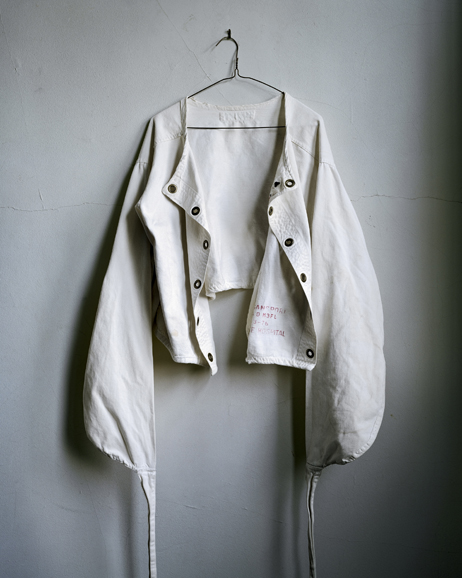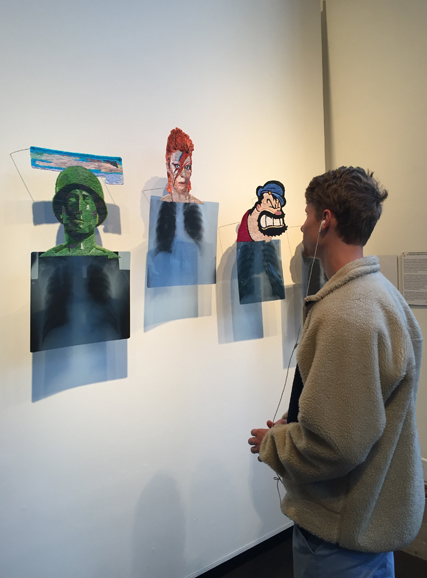Written by Janet T. Langham
Some people believe that healing is an art.
Others assert it is a science. I prefer to think of healing as both an art and a science. Intellectually, I take for granted the science part. Yet perceptually, I continue to be fascinated by the effect of the arts on wellness. One can look at leading hospitals such as Westchester Medical Center for confirmation that the medical profession has embraced the restorative power of the arts. They are bringing artwork into treatment centers, hiring art therapists to work with patients and turning those green hospital walls into more attractive canvases.
The merging of art and science is a familiar theme for ArtsWestchester just as the merging of mind and body is critical to health care. Thus ArtsWestchester turns a surgical lens on the arts and medicine in its fall exhibition, “Remedy” (through Jan. 14), curated by gallery director Kathleen Reckling. The exhibit is meant to open up a dialogue on the many ways in which the arts can promote healing in both personal and collective settings.
Working across media, the contributing artists engage with the tools, institutions and methods of healing, as well as the roles artists and art can play in the process of personal and collective healing. Laura Splan’s “Prozac, Thorazine, Zoloft” creations blend humor and craft with modern medicine as she raises questions about what can provide comfort in times of physical or mental distress. Splan’s soft sculptures, made through the tedious and time-consuming process of latch hooking, transform these commonly prescribed antipsychotics and antidepressants into cozy, domestic objects. The oversized pill-ows provide a different kind of comfort than their prescription counterparts.
“Asylum” is a captivating body of work by New York photographer Christopher Payne, who documented some 70 abandoned mental institutions in 30 states. Payne’s photographs are both lyrical and ghostly portraits of a forgotten age of mental health care. Today, these institutions of healing, controversial even in their day, are in need of healing themselves, condemned and replaced by outpatient facilities.
Arizona-based artist Annie Lopez melds old photographic techniques with her Latina heritage to confront her father’s battle with Alzheimer’s and its effect on her family. Using photocopies of medical books as well as written memories from family members as visual source material, Lopez prints these images onto tamale wrappers via the cyanotype process and stitches the wrappers together as dresses. “The idea of wearing my burdens has always been intriguing to me,” Lopez says in a statement. “If my issues (or accomplishments) are on my clothes, I no longer have to think about them. They would be everyone else’s to consider or ignore.”
Irvington-based photographer Carol Pfeffer is inspired by current neuroscience research. Her “Brain State” series interprets sensory events in the brain’s cortexes and explores neurological issues such as synesthesia, a phenomenon in which the stimulation of one sense involuntarily induces perception of another sense. The works are created through chemical and light exposures in a darkroom without the use of an actual camera.
Some of the most interesting pieces are by Dianne Aronian of Yorktown Heights, an artist whose work reflects her former career as an opthamologist. Photographer Richard Falco of North Salem throws a light on the role of art and music in therapy programs, including music for autistic children and wheelchair dance. The work of Samantha Yergo of Mamaroneck presents an internal, visceral and entangled visual whereas sculptor Jacqueline Lorieo of Yonkers leans on her medical background in her forms and themes while Guyanese-American performance artist Damalia Abrams is interested in the ways traditional remedies can both heal the self and nonmedical ailments plaguing our society.
Taken as a whole, “Remedy” reminds us that art is a remedy in and of itself, Reckling says:
“It can give us a voice when words have felt insufficient or can provide communities with safe havens in times of collective suffering. The work in ‘Remedy’ is provocative, it is humorous and it is also poignant.”
Janet T. Langsam is CEO of ArtsWestchester. Gallery hours are noon to 5 p.m. Tuesdays through Fridays and noon to 6 p.m. Saturdays at 31 Mamaroneck Ave. in White Plains. For more, visit artswestchester.org.


